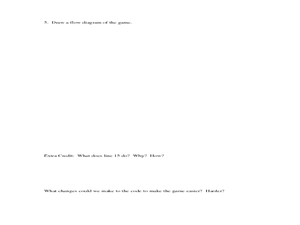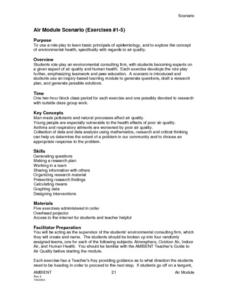Curated OER
Mastering Verbs
Second graders will master verbs. In this language arts lesson students will spend extra time working with verbs, and mastering the past, present, and future tenses of commonly used verbs. The students will engage in several activities...
Curated OER
TI Math, Games
Students solve problems using technology. In this algebra lesson, students apply flow diagrams and computer codes to solve problems. They use the TI to view the graphs.
Curated OER
Monuments, Memorials and Public Spaces
Monument and memorial lesson plans can get students thinking about important topics and time periods in history.
Curated OER
Making Tutoring Sessions Work for Students
Here are some effective strategies to use when tutoring students.
Curated OER
Mom, Where Do TV's Come From?
Students explore the history of television using the lifetime achievements of Milton Berle as a springboard for studying social and technological advances in American entertainment. They, in groups, examine the role of television through...
Curated OER
Water Cycle (Grades 2-4)
Students demonstrate their understanding of the water cycle and how it effects the environment by graphically depicting and describing the water cycle.
Learning to Give
Africa - The Great Southland
Applying the five themes of geography, preteen explorers develop a visual aid for younger learners in celebration African American History Month. They investigate the political, geographic, economic, and social aspects of the continent...
Curated OER
Rock-A-Bye Pendulum
Third graders analyze the effects of force on an object in motion and its relationship to a change in speed. This lesson uses a pendulum to demonstrate the principle.
Curated OER
The Seed Connection
Second graders investigate the best conditions for growing plants while considering how math, science, and technology are interrelated in this study. They partner with an upper grade through the use of the Internet and conduct a...
Curated OER
The Influence of Jazz Music in Twentieth Century Art
Students examine the effect of music on society. While listening to music, they identify the beat, rhythm and write down their reaction to it. Listening to longer selections, they assign a color to the music and share it with the...
Curated OER
Air Module Scenario (Exercises #1-5)
Students, after researching/analyzing the concept of environmental health to air quality, role-play the basic principals of epidemiology. They act out a specific scenario to generate questions, draft a research plan, and generate...
Curated OER
Role Playing in North America: Mid 1600s-Mid 1700s
Eighth graders apply their knowledge of North American history from the mid 1600's through the mid 1700's to a role-playing scenario. In small groups they plan, write, and perform a dramatic skit of a group that was affected by events in...
Curated OER
Laurence Yep's Dragonwings
Middle schoolers read independently the novel, "Dragonwings," by Laurence Yep and make connections between a text and the world. They summarize, paraphrase, analyze and evaluate skimming and scanning techniques when reading a novel. Each...
Curated OER
Abuse and Neglect: United Nations Conventions on the Rights of the Child
Young scholars analyze the consequences of inadequate or inappropriate care giving (e.g., the effects of neglect or abuse). They analyze the influences that have impact on growth and development during adolescence. Pupils analyze...
Curated OER
Geological Features: How Weathering & Erosion Help Create Landforms
Students explore how the Earth's surface changes resulting in geological features and landforms. They perform a read-a-loud on Thomas
Locker's Mountain Dance, complete a KWL chart, and create a
landform using plaster of paris.
National First Ladies' Library
Eleanor Roosevelt: Economics, Discovery and Daily Life
Examine the causes and effects of the Great Depression and the role of Eleanor Roosevelt during the era. Pupils take an inventory of their home for wants and needs, and conduct online research on The Great Depression. They then convert...
Curated OER
The Motion of Molecules in Water
Students observe the motion of water molecules using food coloring. For this molecule movement lesson plan, students observe motion in hot, cold and room temperature colored water and record observation data on record sheets. Then write...
Curated OER
A Fish Tale
Students investigate the lives of fish. In this biology lesson plan, students demonstrate how fish cells respond to fresh and salty water, determine the age of a fish and if temperature effects the movement of a fish's operculum (gill...
Curated OER
Scarcity, Choice and Decisions
Students study the basic economic trilogy (scarcity, choice, and costs). For this money management lesson, students use a scenario of a High School Prom to calculate how scarcity, choice and cost apply by completing provided worksheets...
Curated OER
Biomes and the water cycle
Students create a desert biome and a prairie biome and see how plants survive in both. For this biomes lesson plan, studnets create their biomes and see how the water cycle effect each biome and plant differently.
Curated OER
Alice Computer Programming
Students explore multimedia components. In this science inquiry lesson, students read "Invitation to the Game" by Monica Hughes and they use the Alice Computer Programming System to better understand population dynamics.
Curated OER
Have a Ball with Bernoulli
Third graders investigate Bernoulli's Principle. In this Bernoulli's Principle activity, 3rd graders examine blowing air through a tube and the movement of the ball. Students make inquiries into what effect the air has on the ball and...
Curated OER
Why is The Sky Blue?
Students explore why the sky is blue. In this light lesson, students conduct an experiment using water, flashlights, and milk to test why the sky is blue. Students view a PowerPoint, take notes on their results and draw conclusions.
Curated OER
Math Journal: Functions and Coordinate Geometry
Fifth graders examine the many uses of coordinate grids. In this graphing lesson, 5th graders write data driven equations, discuss the x and y-axis, and determine if using 2 or 3 ordered pairs is better. Students complete several...

























